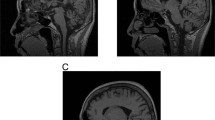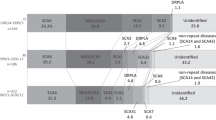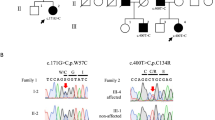Abstract
Two forms of the neurodegenerative disorder spinocerebellar ataxia are known to be caused by the expansion of a CAG (polyglutamine) trinucleotide repeat. By screening cDNA expression libraries, using an antibody specific for polyglutamine repeats, we identified six novel genes containing CAG stretches. One of them is mutated in patients with spinocerebellar ataxia linked to chromosome 12q (SCA2). This gene shows ubiquitous expression and encodes a protein of unknown function. Normal SCA2 alleles (17 to 29 CAG repeats) contain one to three CAAs in the repeat. Mutated alleles (37 to 50 repeats) appear particularly unstable, upon both paternal and maternal transmissions. The sequence of three of them revealed pure CAG stretches. The steep inverse correlation between age of onset and CAG number suggests a higher sensitivity to polyglutamine length than in the other polyglutamine expansion diseases.
This is a preview of subscription content, access via your institution
Access options
Subscribe to this journal
Receive 12 print issues and online access
$209.00 per year
only $17.42 per issue
Buy this article
- Purchase on Springer Link
- Instant access to full article PDF
Prices may be subject to local taxes which are calculated during checkout
Similar content being viewed by others
References
Harding, A.E. The clinical features and classification of the late onset autosomal dominant cerebellar ataxias. A study of 11 families, including descendants of the ‘the Drew family of Walworth’. Brain 105, 1–28 (1982).
Zoghbi, H.Y. The spinocerebellar degenerations. Curr Neurol. 11, 121–144 (1991).
Orozco, G., Nodarse, A., Cotdoves, R. & Auburger, G. Autosomal dominant cerebellar ataxia: clinical analysis of 263 patients from a homogeneous population in Holguin, Cuba. Neurology 40, 1369–1375 (1990).
Ranum, L.P. et al. Spinocerebellar ataxia type 1 and Machado-Joseph disease: incidence of CAG expansions among adult-onset ataxia patients from 311 families with dominant, recessive, or sporadic ataxia. Am. J. Hum. Genet. 57, 603–608 (1995).
Kawaguchi, Y. et al. CAG expansions in a novel gene for Machado-Joseph disease at chromosome 14q321.. Nature Genet. 8, 221–228 (1995).
Orr, H.T. et al. Expansion of an unstable trinucleotide CAG repeat in spinocerebellar ataxia type 1. Nature Genet. 4, 221–226 (1993).
Allotey, R. et al. The spinocerebellar ataxia 2 locus is located within a 3-cM interval on chromosome 12q23–24.1. Am. J. Hum. Genet. 57, 185–189 (1995).
Gispert, S. et al. Chromosomal assignment of the second locus for autosomal dominant cerebellar ataxia (SCA2) to chromosome 12q23–24.1. Nature Genet. 4, 295–299 (1993).
Myers, R.H. et al. De novo expansion of a (CAG)n repeat in sporadic Huntingdon's disease. Nature Genet. 5, 168–173 (1993).
Bürk, K. et al. Autosomal dominant cerebellar ataxia type I: Clinical feature and magnetic resonance imaging in families with SCA1, SCA2 and SCA3. Brain (in the press).
Benomar, A. et al. The gene for autosomal dominant cerebellar ataxia with pigmentary macular dystrophy maps to chromosome 3p12–p21.1. Nature Genet. 10, 84–88 (1995).
Holmberg, M. et al. Localization of autosomal dominant cerebellar ataxia associated with retinal degeneration and anticipation to chromosome 3p12–p21.1 Hum. Mol. Genet. 4, 1441–1445 (1995).
Paulson, H.L. & Fischbeck, K.H. Trinucleotide repeats in neurogenetic disorders. Annu. Rev. Neurosci. 19, 79–107 (1996).
Ranen, N.G. et al. Anticipation and instability of IT-15 (CAG)n repeats in parent–offspring pairs with Huntington disease. Am. J. Hum. Genet. 57, 593–602 (1995).
Kremer, B. et al. Sex-dependent mechanisms for expansions and contractions of the CAG repeat on affected Huntington disease chromosomes. Am. J. Hum. Genet. 57, 343–350 (1995).
Duyao, M.P. et al. Trinucleotide repeat length instability and age of onset in Huntington's disease. Nature Genet. 4, 387–392 (1993).
Trottier, Y., Biancalana, V. & Mandel, J.L. Instability of CAG repeats in Huntington's disease: relation of parental transmission and age of onset. J. Med. Genet. 31, 377–382 (1994).
Chung, M.Y. et al. Evidence for a mechanism predisposing to intergenerational CAG repeat instability in spinocerebellar ataxia type I. Nature Genet. 5, 254–258 (1993).
Ikeuchi, T. et al. Dentatorubral-pallidoluysian atrophy: Clinical features are closely related to unstable expansions of trinucleotide (CAG) repeat. Ann. Neurol. 37, 769–775 (1995).
La Spada, A.R. et al. Meiotic stability and genotype-phenotype correlation of the trinucleotide repeat in X-linked spinal and bulbar muscular atrophy. Nature Genet. 2, 301–304 (1992).
Biancalana, V. et al. Moderate instability of the trinucleotide repeat in spino bulbar muscular atrophy. Hum. Mol. Genet. 1, 255–258 (1992).
Igaraschi, S. et al. Intergenerational instability of the CAG repeat of the gene for Machado-Joseph (MJD1) is affected by the genotype of normal chromosome: implications for the molecular mechanisms of the instability of the CAG repeat. Hum. Mol. Genet. 5, 923–932 (1996).
Dürr, A. et al. Spinocerebellar ataxia 3 and Machado-Joseph disease: clinical, molecular, and neuropathological features. Ann. Neurol. 39, 490–499 (1996).
Ross, C.A., Mclnnis, M.G., Margolis, R.L. & Li, S.-H. Genes with triplets: candidate mediators of neuropsychiatric disorders. Trends Neurosci. 16, 254–260 (1993).
Lescure, A. et al. The N-terminal domain of the human TATA-binding protein plays a role in transcription from TATA-containing RNA polymerase II and III promoters. EMBO J. 13, 1166–1175 (1995).
Trottier, Y. et al. Polyglutamine expansion as a pathological epitope in Huntington's disease and four dominant cerebellar ataxias. Nature 378, 403–406 (1995).
Dürr, A. et al. Autosomal dominant cerebellar ataxia type I in Martinique (French West Indies): clinical and neuropathological analysis of 53 patients from three unrelated SCA2 families. Brain 118, 1573–1581 (1995).
Belal, S. et al. Clinical and genetic analysis of a tunisian family with autosomal dominant cerebellar ataxia type 1 linked to the SCA2 locus. Neurology 44, 1423–1426 (1994).
Ihara, T. et al. Genetic heterogeneity of dominantly inherited olivopontocerebellar atrophy (OPCA) in the Japanese: linkage study of two pedigrees and evidence for the disease locus on chromosome 12q (SCA2). Jap. J. Hum. Genet. 39, 305–313 (1994).
Gispert, S. et al. Localization of the candidate gene D-amino acid oxidase outside the refined I-cM region of spinocerebellar ataxia 2. Am. J. Hum. Genet. 57, 972–975 (1995).
Lezin, A. et al. Autosomal dominant cerebellar ataxia type I in Martinique (French West Indies): genetic analysis of three unrelated SCA2 families. Hum. Genet. 97, 671–676 (1996).
Chiba, H., Muramatsu, M., Nomoto, A. & Kato, H. Two human homologues of Saccharomyoes cerevisiae SWI2/SNF2 and Drosophila brahma are transcriptional coactivators cooperating with the estrogen receptor and the retinoic acid receptor. Nucl. Acids Res. 22, 1815–1820 (1994).
Kang, S., Jaworski, A., Ohshima, K. & Wells, R. Expansion and deletion of CTG repeats from human disease genes are determined by the direction of replication in E. Coli. Nature Genet. 10, 213–218 (1995).
Krauter, K. et al. A second-generation YAC contig map of human chromosome 12. Nature 377, 321–333 (1995).
Kozak, M. An analysis of 5′-noncoding sequences from 699 vertebrate messenger RNAs. Nucl Acids Res. 15, 8125–8148 (1987).
Uberbacher, E.C. & Mural, R.J. Locating protein-coding regions in human DMA sequences by a multiple sensor-neural network approach. Proc. Natl. Acad. Sci. USA 88, 11261–11265 (1991).
Jiang, J.-X., Lekanne Deprez, R., Zwarthoff, E. & Riegman, P. Characterization of four novel CAG repeat-containing cDNAs. Genomics 30, 91–93 (1995).
Gastier, J.M. et al. Development of a screening set for new (CAG/CTG)n dynamic mutations. Genomics 32, 75–85 (1996).
Li, S.H., Mclnnis, M.G., Margolis, R.L., Antonarakis, S.E. & Ross, C.A. Novel triplet repeat containing genes in human brain: cloning, expression, and length polymorphisms. Genomics 16, 572–579 (1993).
Riggins, G.J. et al. Human genes containing polymorphic trinucleotide repeats [published erratum appears in Nature Genet. 3, 273 (1993)]. Nature Genet. 2, 186–191 (1992).
Neri, C. et al. Survey of CAG/CTG repeats in human cDNAs representing new genes: candidates for inherited neurological disorders. Hum. Mol. Genet. 5, 1001–1009 (1996).
Ross, C. When more is less: pathogenesis of glutamine repeat neurodegenerative diseases. Neuron 15, 493–496 (1995).
Rubinsztein, D.C. et al. Phenotypic characterization of individuals with 30–40 CAG repeats in the Huntington disease (HD) gene reveals HD cases with 36 repeats and apparently normal elderly individuals with 36–39 repeats. Am. J. Hum. Genet. 59, 16–22 (1996).
Kremer, B. et al. A worldwide study of the Huntington's disease mutation: the sensitivity and specificity of measuring CAG repeats. N. Engl. J. Med. 330, 1402–1406 (1994).
Maruyama, H. et al. Molecular features of the CAG repeats and clinical manifestation of Machado-Joseph disease. Hum. Mol. Genet. 4, 807–812 (1995).
Chong, S.S. et al. Gametic and somatic tissue-specific heterogeneity of the expanded SCA1 CAG repeat in spinocerebellar ataxia type 1. Nature Genet. 10, 344–350 (1995).
Hansen, R.S., Canfield, T.K., Lamb, M.M., Gartler, S.M. & Laird, C.D. Association of fragile X syndrome with delayed replication of the FMR1 gene. Cell 73, 1403–1409 (1993).
Gusella, J.F. & MacDonald, M.E. Huntington's disease: CAG genetics expands neurobiology. Curr. Opin. Neurobiol. 5, 656–662 (1995).
Ranum, L.P. et al. Molecular and clinical correlations in spinocerebellar ataxia type I: evidence for familial effects on the age at onset. Am. J. Hum. Genet. 55, 244–252 (1994).
Imbert, G., Trottier, Y., Beckman, J. & Mandel, J.-L. The gene for the TATA-binding protein (TBP) that contains a highly polymorphic protein coding CAG repeat maps to 6q27. Genomics 21, 667–668 (1994).
Ikeda, H., Yamaguchi, M., Sugai, S., Aze, Y., Narumiya, S. & Kakizuka, A. Expanded polyglutamine in the Machado-Joseph disease protein induces cell death in vitro and in vivo. Nature Genet. 13, 196–202 (1996).
Pulst, S.-M., Nechiporuk, A. & Starkman, S. Anticipation in spinocerebellar ataxia type 2. Nature Genet. 5, 8–10 (1993).
Eichler, E.E. et al. Length of uninterrupted CGG repeats determines instability in the FMR1 gene. Nature Genet. 8, 88–94 (1994).
Kunst, C.B. & Warren, S.T. Cryptic and polar variation of the fragile X repeat could result in predisposing normal alleles. Cell 77, 853–861 (1994).
Matsufuji, S. et al. Autoregulatory frameshifting in decoding mammalian ornithine decarboxylase antizyme. Cell 80, 51–60 (1995).
Gesteland, R.F., Weiss, R.B. & Atkins, J.F. Receding: reprogrammed genetic decoding. Science 257, 1640–1641 (1992).
Pulst, S.M. et al. Moderate expansion of a normally biallelic trinucleotide repeat in spinocerebellar ataxia type 2. Nature Genet. 14, 269–276 (1996).
Sampei, K. et al. Identification of the gene for spinocerebellar ataxia type 2, SCA2, using a direct identification of repeat expansion and cloning technique, DIRECT. Nature Genet. 14, 277–284 (1996).
Ashley, C.T. et al. Human and murine FMR-1: alternative splicing and translational initiation downstream of the CGG repeat. Nature Genet. 4, 244–251 (1993).
Broholm, J. et al. Guidelines for the molecular genetics predictive test in Huntington's disease. Neurology 44, 1533–1536 (1994).
Bouillet, P. et al. Efficient cloning of cDNAs of retinoic acid-responsive genes in P19 embryonal carcinoma cells and characterization of a novel mouse gene, Stra1 (mouse LERK-2/Eplg2). Dev. Biol. 170, 420–433 (1995).
Author information
Authors and Affiliations
Rights and permissions
About this article
Cite this article
Imbert, G., Saudou, F., Yvert, G. et al. Cloning of the gene for spinocerebellar ataxia 2 reveals a locus with high sensitivity to expanded CAG/glutamine repeats. Nat Genet 14, 285–291 (1996). https://doi.org/10.1038/ng1196-285
Received:
Accepted:
Issue Date:
DOI: https://doi.org/10.1038/ng1196-285
This article is cited by
-
TR-FRET-Based Immunoassay to Measure Ataxin-2 as a Target Engagement Marker in Spinocerebellar Ataxia Type 2
Molecular Neurobiology (2023)
-
Cognitive Decline Is Closely Associated with Ataxia Severity in Spinocerebellar Ataxia Type 2: a Validation Study of the Schmahmann Syndrome Scale
The Cerebellum (2022)
-
Intracellular dynamics of Ataxin-2 in the human brains with normal and frontotemporal lobar degeneration with TDP-43 inclusions
Acta Neuropathologica Communications (2020)
-
Enhancement of Autophagy and Solubilization of Ataxin-2 Alleviate Apoptosis in Spinocerebellar Ataxia Type 2 Patient Cells
The Cerebellum (2020)
-
Insights into cognitive decline in spinocerebellar Ataxia type 2: a P300 event-related brain potential study
Cerebellum & Ataxias (2019)



